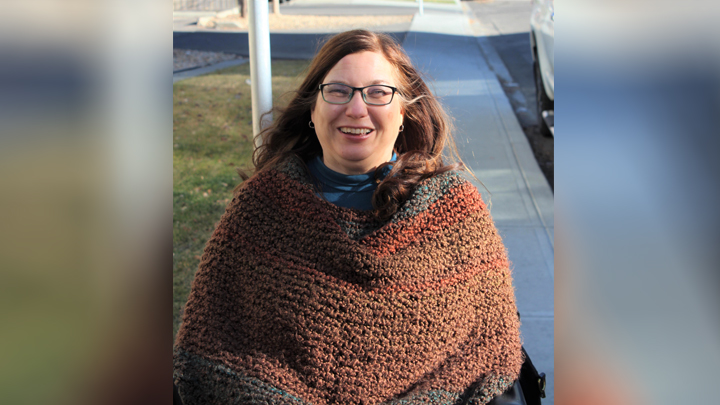
January 24, 2022

Nicola Birchall enjoys some sunshine and fresh air from the seat of her motorized wheelchair. Living with paralysis after a workplace accident many years ago, she keeps an eye on any signs of potentially life-threatening pressure injuries that she may not even feel.
Story by Shane Westin | Photo by Christine Liu
Suffering a spinal cord injury and being confined to a wheelchair is a scary thought.
For Nicola Birchall, it became reality 26 years ago when, as a rehabilitation assistant, a workplace injury damaged her spinal cord and left her paralyzed.
What scares her today is the very real possibility of a life-threatening pressure injury that she may not even feel.
“It was hard on my mental state,” says Birchall, in recalling her first pressure injury. “It put me back in bed and emotionally took me right back to when my injury happened — and the fear of not being able to return to an active life. I felt really isolated.”
Since that first pressure injury, caused by her back brace, Birchall has suffered others caused by conditions as seemingly innocuous as a wrinkle in a pressure stocking.
“That was another scary time,” she adds, “I was still able to work but, because of the pressure injury, I was unable to wear my pressure stockings. The pressure stockings I wear prevent swelling in my legs and from getting blood clots going to my heart or lungs.”
That pressure injury took more than two years to heal.
Checking for pressure injuries has become part of a daily routine for Birchall and care providers who assist her to shower and dress.
“I have them check all the time because something could be going on and I wouldn’t feel it,” she says, pointing out that it’s not just people with spinal cord injuries who are at risk.
As an Alberta Health Services (AHS) patient advisor and volunteer, she encourages people with mobility impairment, new injuries or illness, or even diminished sensitivity, should always be checking for possible pressure injuries.
“A pressure injury can completely change the way you live your life and impacts the entire family,” she says.
“Not to scare people — because you don’t want to be scared to live your life — but they often happen because the person isn’t able to feel it happening. And if you can’t feel something, you’re not necessarily going to look for it.”
The solution, she believes, is to educate patients, families and care providers how to recognize the early signs of pressure injuries — and how to prevent them.
Birchall adds: “It just needs to be an everyday topic of conversation; part of your daily routine.”
AHS and Covenant Health are working collaboratively to raise awareness and promote programs to prevent the development of pressure injuries, which are also known as bedsores, pressure sores or pressure ulcers.
The recently created Pressure Injury Community of Practice (CoP) held their first meeting in December. The CoP provides an opportunity to learn and share stories, ideas and best practices in the prevention and management of pressure injuries. To join the CoP, email Paul Wright at paul.wright@ahs.ca.